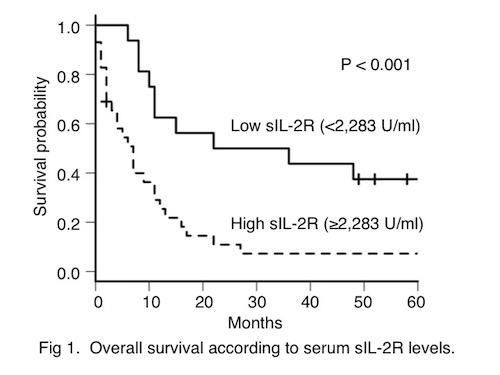
Contributions
Abstract: PB1716
Type: Publication Only
Background
The prognosis is extremely poor for cases of relapsed/refractory peripheral T cell lymphoma, not otherwise specified (PTCL-NOS), and there are no established predictors of prognosis. Although serum soluble interleukin-2 receptor (sIL-2R) levels are associated with clinical outcomes in newly diagnosed patients with PTCL-NOS, it remains unclear whether sIL-2R levels can predict prognosis in patients with relapsed/refractory PTCL-NOS.
Aims
This study evaluated whether sIL-2R levels at the time of salvage chemotherapy were associated with prognosis in cases of relapsed/refractory PTCL-NOS.
Methods
We retrospectively analyzed 45 patients with relapsed/refractory PTCL-NOS who received salvage chemotherapy at our institutions (1996–2016). All patients received CHOP or CHOP-like therapy as their initial treatment. The primary outcome was defined as overall survival (OS), which was calculated from the date of the salvage chemotherapy to the date of death from any cause or the last follow-up.
Results
The median age at salvage chemotherapy was 68 years (range: 37–86 years). The median serum sIL-2R level was 3,476 U/mL (range: 280–24,400 U/mL). Receiver operating characteristic curve analysis revealed that the optimal sIL-2R cut-off value for predicting OS was 2,283 U/mL (area under the curve: 0.672, 95% confidence interval [CI]: 0.421–0.923). Thus, we defined patients with serum sIL-2R levels of ≥2,283 U/mL as the high sIL-2R group and the other patients as the low sIL-2R group. The two groups had similar clinical characteristics at the salvage chemotherapy, with the exception of their international prognostic index (secondary IPI) and performance status (PS). The high sIL-2R group had significantly higher secondary IPI (≥H-I) and poorer PS (≥2). Eight patients were alive at the time of the analysis, with a median follow-up of 55 months (range: 2–136 months). The 2-year OS among all patients was 25.1% (95% CI: 13.6–38.5), and the high sIL-2R group had significantly poorer 2-year OS (10.9%, 95% CI: 2.8–25.4 vs. 50.0%, 95% CI: 24.5–71.0, P < 0.001). A multivariate analysis was performed using the following factors: serum sIL-2R levels (high vs. low), secondary IPI (≥H-I vs.

Conclusion
Serum sIL-2R levels are a useful predictor of prognosis in cases of relapsed/refractory PTCL-NOS, especially among patients with low secondary IPI risk.
Session topic: 20. Aggressive Non-Hodgkin lymphoma - Clinical
Keyword(s): Relapsed lymphoma, Prognostic factor
Abstract: PB1716
Type: Publication Only
Background
The prognosis is extremely poor for cases of relapsed/refractory peripheral T cell lymphoma, not otherwise specified (PTCL-NOS), and there are no established predictors of prognosis. Although serum soluble interleukin-2 receptor (sIL-2R) levels are associated with clinical outcomes in newly diagnosed patients with PTCL-NOS, it remains unclear whether sIL-2R levels can predict prognosis in patients with relapsed/refractory PTCL-NOS.
Aims
This study evaluated whether sIL-2R levels at the time of salvage chemotherapy were associated with prognosis in cases of relapsed/refractory PTCL-NOS.
Methods
We retrospectively analyzed 45 patients with relapsed/refractory PTCL-NOS who received salvage chemotherapy at our institutions (1996–2016). All patients received CHOP or CHOP-like therapy as their initial treatment. The primary outcome was defined as overall survival (OS), which was calculated from the date of the salvage chemotherapy to the date of death from any cause or the last follow-up.
Results
The median age at salvage chemotherapy was 68 years (range: 37–86 years). The median serum sIL-2R level was 3,476 U/mL (range: 280–24,400 U/mL). Receiver operating characteristic curve analysis revealed that the optimal sIL-2R cut-off value for predicting OS was 2,283 U/mL (area under the curve: 0.672, 95% confidence interval [CI]: 0.421–0.923). Thus, we defined patients with serum sIL-2R levels of ≥2,283 U/mL as the high sIL-2R group and the other patients as the low sIL-2R group. The two groups had similar clinical characteristics at the salvage chemotherapy, with the exception of their international prognostic index (secondary IPI) and performance status (PS). The high sIL-2R group had significantly higher secondary IPI (≥H-I) and poorer PS (≥2). Eight patients were alive at the time of the analysis, with a median follow-up of 55 months (range: 2–136 months). The 2-year OS among all patients was 25.1% (95% CI: 13.6–38.5), and the high sIL-2R group had significantly poorer 2-year OS (10.9%, 95% CI: 2.8–25.4 vs. 50.0%, 95% CI: 24.5–71.0, P < 0.001). A multivariate analysis was performed using the following factors: serum sIL-2R levels (high vs. low), secondary IPI (≥H-I vs.

Conclusion
Serum sIL-2R levels are a useful predictor of prognosis in cases of relapsed/refractory PTCL-NOS, especially among patients with low secondary IPI risk.
Session topic: 20. Aggressive Non-Hodgkin lymphoma - Clinical
Keyword(s): Relapsed lymphoma, Prognostic factor


